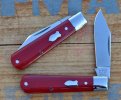- Joined
- Feb 7, 2024
- Messages
- 7
Hello all,
I’ve been a longtime reader of this forum and have learned a lot here but just recently joined myself. I was hoping to run a question by you folks. I tried to look it up first but didn’t see anything about it.
When I work with G-10 for handles, I often get a white ring or discoloration around some of the pins after grinding. I never really seem to have this problem with micarta, etc. I do use very slightly oversize bits (e.g., F size for 1/4”), but generally find this is the only way to have the pins fit properly. I use corby bolts on pretty much all of my knives, so the slight oversize doesn’t have any functionality issues.
Would you folks mind letting me know if you’ve experienced this and if you have any fixes? Thanks so much in advance, and my sincere apologies if I missed another thread about this!
I’ve been a longtime reader of this forum and have learned a lot here but just recently joined myself. I was hoping to run a question by you folks. I tried to look it up first but didn’t see anything about it.
When I work with G-10 for handles, I often get a white ring or discoloration around some of the pins after grinding. I never really seem to have this problem with micarta, etc. I do use very slightly oversize bits (e.g., F size for 1/4”), but generally find this is the only way to have the pins fit properly. I use corby bolts on pretty much all of my knives, so the slight oversize doesn’t have any functionality issues.
Would you folks mind letting me know if you’ve experienced this and if you have any fixes? Thanks so much in advance, and my sincere apologies if I missed another thread about this!

